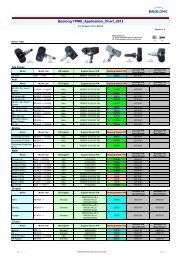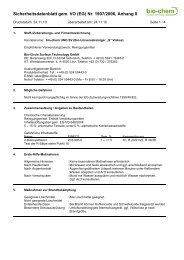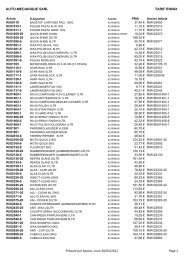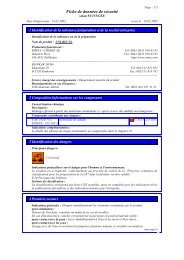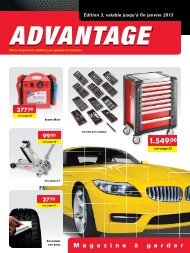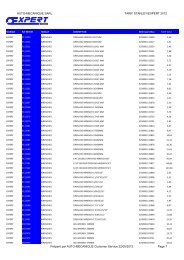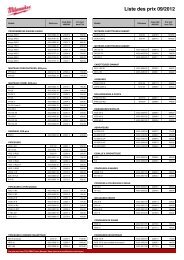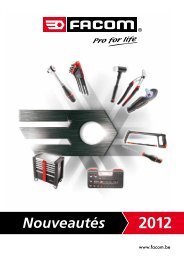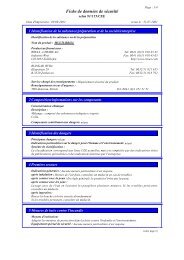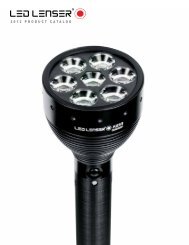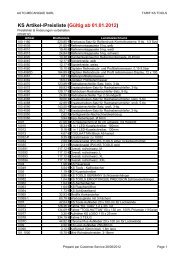REPAIR & SUPPLIES - Auto-Mecanique
REPAIR & SUPPLIES - Auto-Mecanique
REPAIR & SUPPLIES - Auto-Mecanique
Create successful ePaper yourself
Turn your PDF publications into a flip-book with our unique Google optimized e-Paper software.
Industry standard section repair procedures<br />
INITIAL TIRE INSPECTION<br />
1. An injury that penetrates 75% or more of the body plies and exceeds<br />
puncture repair limits requires a section repair. DO NOT attempt to repair<br />
this type of damage with nail hole repair units. Demount the tire from the<br />
wheel and locate the injury.<br />
2. Remove any injuring object and make a careful visual inspection<br />
to determine the size, angle, and extent of the injury. Use a probing awl to<br />
probe for unseen internal damage. Determine whether the injury is within<br />
repairable limits. (See page 111 for section repair limits and page 112<br />
for non-repairable conditions.)<br />
FILLING THE INJURY AREA<br />
Preparing the Outside of the Tire<br />
3. Using a low speed buffer and a carbide cutter, begin removing all<br />
damaged rubber, both inside and outside the tire, and steel cord in the<br />
injury area. All broken cords and loose strands of cable must be removed<br />
leaving only solid, undamaged rubber at the sides of the opening. If in the<br />
tread area, use an appropriate buffing wheel to buff at a 45˚ angle down<br />
to the cord and 90˚ through the cord.<br />
4. Using a high speed buffer with a pencil stone, polish the exposed cord<br />
ends being careful not to scorch the rubber. Clean away any rubber or<br />
steel dust left behind both inside and outside the tire. Using a low speed<br />
buffer and an<br />
appropriate buffing wheel, round over the edges of the prepared area.<br />
Preparing the Inside of the Tire<br />
5. Clean the inner liner around the injury area with a pre-buff chemical<br />
rubber cleaner. Using an inner liner scraper, remove dirt, mold lubricants,<br />
and other contaminants.<br />
6. Using a low speed buffer with an appropriate buffing wheel, buff an area<br />
about 1" larger than the injury area to an RMA #1 texture (see bottom of<br />
page 113). As on the other side, round over the edges of the prepared<br />
area. Use a vacuum cleaner to remove buffing dust.<br />
7. Measure the thickness of the tire at the injury area and note this<br />
measurement for future reference. Also measure and record the<br />
dimensions of the repair area.<br />
8. Spread a generous coating of Black Retreader's Cement over the<br />
prepared injury area both inside and outside the tire.<br />
<strong>REPAIR</strong> UNIT APPLICATION<br />
10. Select the appropriate repair unit and center it over the injury on the<br />
inner liner. Mark an area about 1/2" (13mm) larger than the selected<br />
repair unit. Clean the selected area completely with a pre-buff rubber<br />
cleaner. Using an inner<br />
liner scraper, remove all dirt, mold lubricants, and other contaminants.<br />
11. Using a low speed buffer and an appropriate buffing wheel, buff<br />
the selected area to an RMA #1 texture (see bottom of page 113).<br />
Remove all buffing dust with a vacuum.<br />
12. Using a chemical vulcanizing cement recommended by the repair<br />
manufacturer, apply a thin, even coating to the prepared and buffed<br />
surface. Allow cement to dry thoroughly!<br />
13. While beads are in a relaxed position, remove backing from<br />
repair unit and center the repair over the injury. Stitch repair down<br />
thoroughly with a stitching tool, working from the center out,<br />
removing all trapped air and making sure to stitch the edges.<br />
14. Once the repair unit has been stitched down, apply a generous<br />
coating of Inner Liner Sealer to the edges of the repair unit.<br />
FINISHING THE <strong>REPAIR</strong><br />
15. Using a low speed buffer and an appropriate buffing wheel,<br />
lightly buff the outside of the repaired area until the rubber is<br />
flush with the surrounding area, presenting a smooth finished<br />
appearance.<br />
16. For tread area repairs, use a regroover to replace original tread<br />
design. For sidewall repairs, apply a Section ID Patch on the outside<br />
of the tire next to the repaired area to indicate the location of the<br />
section repair.<br />
Filling the Injury<br />
9. Secure a backing plate on the inner liner. Fill the injury area with an<br />
appropriate filling material.Stitch and pack material so as to avoid creating<br />
any gaps or air pockets, working from the center outward, making sure<br />
to stitch rubber over the edges. Filling material should be about 1/8"<br />
(3mm) above the outside of the tire when finished packing. Remove the<br />
backing plate and cure the filling material following manufacturer’s cure<br />
time recommendations.<br />
Tire repair DVD's available from 31 Inc.<br />
Ask for details<br />
Keeping You On the Road 115



